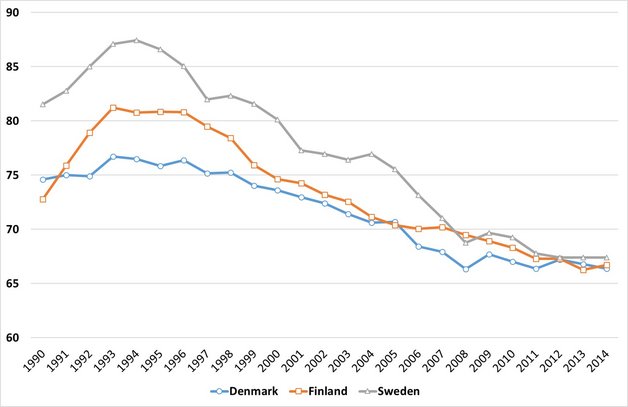Trade union-administered unemployment benefit and precarious workers in Finland
The Nordic countries have some of the highest trade union rates of membership in the world. This has by some been attributed to unemployment insurance being largely administered by trade unions. Since around 1910, unemployment insurance in the Nordic countries Denmark, Finland and Sweden has been based on a voluntary system (‘Ghent’), rather than the compulsory system which is common in most other welfare states. However, since 1992, these countries have reformed their insurance schemes, which has had a negative effect on union density. In 1992, Finland introduced an independent fund which is not linked to trade unions, and this has provided workers with a greater number of options concerning unemployment benefits. To workers with low or precarious incomes, the cheaper option of the independent fund can be attractive. While it seems clear that different types of precarious workers choose different types of unemployment insurance options, the introduction of funds not linked to trade unions is likely to have contributed to the already decreasing level of trade union membership in the Ghent countries.

Unemployment insurance in Denmark, Finland and Sweden: the Ghent system
Compulsory public unemployment insurance is common in most welfare states to protect people from income insecurity caused by unemployment. However, Denmark, Finland and Sweden operate public unemployment insurance in a different manner based on the ‘Ghent system’, where workers may voluntarily decide whether to join the insurance schemes and usually trade unions or union-affiliated organizations manage these funds and memberships. Voluntary unemployment insurance was used by many European countries in the early 20th century, but the Nordic countries which have maintained the Ghent system are considered the exception nowadays. Many researchers have demonstrated that the system is one of the most powerful institutional factors making these countries have the highest levels of union density in the world, as trade unions play a pivotal role in the system.
Since the 1990s, however, the Nordic Ghent systems have experienced a huge transformation. To begin with, in 1992 and 1998 respectively, Finland and Sweden introduced independent unemployment insurance funds which are entirely independent from trade unions. After that, Denmark lawfully allowed employees to enroll in any unemployment insurance fund regardless of their type of employment in 2002. This means that all unemployment funds can convert to a cross-industry unemployment fund and recruit employees in every industry sector. Thus, workers’ sense of belonging to trade unions is likely to fade. The main reason for promoting these reforms was to offer employees a greater number of options, in step with the dominant ideology of neo-liberalism both in the Nordics and globally, with its focus on individual choice. Many people anticipated that such reforms would affect union density in a negative way and multiple studies have revealed that the predictions have become a reality in recent years. As Figure 1 shows, the union density in those counties has gradually decreased since the mid-1990s.

Figure 1 Union density in the Nordic Ghent countries (% of population). Source: OECD.
Finnish unemployment benefits
| In 2020, the Finnish unemployment security system consists of a three-tier system of unemployment benefits: |
|
| Therefore, an unemployed job-seeker can receive the earnings-related unemployment allowance if he or she had membership of an unemployment insurance fund during the period of employment (number 1). Otherwise, he or she has to rely on the basic unemployment allowance or the labor market subsidy (number 2 or 3). |
In Finland, employees who had difficulty in joining unions due to, for example, their exclusion from collective agreements or the high level of union membership fees, led to the introduction of the independent unemployment insurance fund, and employers and right-wing parties supported their efforts, directly or indirectly. In the early 1990s, the country experienced a severe economic depression and a drastic increase in unemployment. In this situation, where there was a strong argument that employees should have other options than union-affiliated funds, the Finnish Ministry of Social Affairs and Health allowed the establishment of the independent unemployment insurance fund in the autumn of 1991. At that time, trade unions did not actively respond to the decision because they anticipated that the new fund would not have a significant impact on the labor market. However, the independent fund has grown to have a larger number of members than any union-affiliated fund. In addition, the Federation of Finnish Enterprises has publicly expressed their preference for the independent fund, and sometimes right-wing politicians criticize the unions’ strong influence on unemployment insurance and claim that the expansion of the independent fund exemplifies that unions are not necessarily as key to society as was once assumed. In general, it seems that the independent fund has had politically negative effects on unions in the Finnish Ghent system.

People working in precarious employment are not necessarily more likely to ensure they have unemployment insurance as their income levels are lower to spend on such things. They can, however, rely a basic unemployment allowance from the state while they look for another job. Photo: colourbox.dk.
Finnish trade unions play an essential role in the management of the earnings-related unemployment allowance. They jointly manage unemployment insurance funds based on the type of industry and provide unemployment insurance services for their members. As of 2018 when the Finnish population was about 5.5 million people, 26 unemployment funds were in operation. 25 funds are administered by unions, while only one fund (YTK), which was introduced by the Ghent system reform in 1992, is managed independently from unions. Because unions tend to strongly encourage their members to join funds affiliated with themselves, all employees who are members of an unemployment insurance fund but are not union members are members of YTK.
For employees, the biggest difference between joining a union and having a YTK membership is the membership fee. Unions usually charge 1 to 2 % of gross earnings or a flat rate, which is around €400 per year, for their membership, whereas the YTK membership fee is only €110 per year as of 2019. Union membership fees basically include fund membership fees. As the YTK membership fee is much lower compared to union membership fees, this can be an incentive to make workers withdraw from a union and enroll in YTK. On the other hand, in addition to unemployment insurance services, union members have benefits such as travel insurance, job information and occupational training, which are generally provided by unions.
As mentioned above, the basic unemployment allowance has nothing to do with trade unions. Unemployed people who did not have any unemployment insurance fund membership can receive this benefit from KELA. This means that employees can rely on the basic unemployment allowance without paying a union or YTK membership fee when they are out of work. The amount of basic allowance is on average €697 per month (as of 2019) and the maximum payment period is 400 days. Because most unemployed job-seekers who have unemployment insurance membership are eligible for more than 50% of their previous wages and salaries, the basic allowance is likely to be much lower than the earnings-related unemployment allowance.
Precarious workers and unemployment benefit in Finland
Non-standard employment such as part?time or temporary work and low?skilled service jobs have grown over the last couple of decades, and, they have become more uncertain, unpredictable and risky in terms of job and income security in recent decades. The three main groups of precarious workers can be defined as follows:
- A part?time employee is an employee who works fewer than 30 hours per week.
- A temporary employee is an employee who has a fixed?term employment contract.
- A low?skilled service employee is an employee who works in the service industry and whose highest level of education corresponds to ES?ISCED (European Survey Version of International Standard Classification of Education) I or II (less than lower secondary or lower secondary. The ES-ISCED V2 goes up to higher tertiary education which is MA level or above).
According to Statistics Finland, the shares of part-time and temporary employees in the labor market account for 14.6% and 15.6% respectively in 2014. In addition, calculations based on the Finnish Income Distribution Survey (FIDS) data show that the ratio of low-skilled service employees was about 6.2% in 2012. Analysis of the FIDS data demonstrates that the average income of precarious worker groups is much lower than that of other employees. The average income of all Finnish employees was about €37,000 in 2012, whereas those of part-timers and temporary workers was €18,980 and €24,308 respectively, and low-skilled service workers’ average income was €27,386. That is, low-skilled service employees showed the highest average income among the precarious worker groups.
To explore precarious workers’ choices about unemployment insurance membership after the Ghent system reform in Finland, data from the FIDS can be analysed. This shows that, for the period from 2000 to 2012, workers’ choices depend on the type of precarious employment they have. It was found that both part-time and temporary employees do not join any unemployment insurance fund which offers an earnings-related unemployment allowance. Additionally, temporary workers are likely to prefer YTK to union-affiliated funds if they choose to enroll in unemployment insurance. On the other hand, low-skilled service workers do not show any particular preference for YTK or the basic state unemployment allowance.
The reasons for precarious workers’ different choices can be explained as follows:
Part-time employees | · Because of their very low income, it is difficult to guarantee that their earnings-related unemployment allowances will be much higher than the basic one. · Because of their very low income and short working hours, they sometimes do not qualify for earnings-related unemployment allowances in the first place. · Because of their short working hours, they tend not to feel the necessity of joining a union to gain a good reputation from their colleagues. |
Temporary employees | · Because of their fixed-term contracts, they tend to be free from having union membership. (They are less likely to feel pressure to join a union compared to permanent workers, who tend to share the social custom that they need to unite through union membership.) · Because of their pretty low incomes, they are likely to give up the earnings-related unemployment allowance or enroll in YTK whose membership fee is much lower than union membership fees. |
Low?skilled service employees | · Because of their higher incomes than the other precarious worker groups, joining an unemployment insurance fund can guarantee higher earnings-related unemployment allowances than the basic one. · Finnish trade unions in the service sector have been successful in recruiting low-skill service workers. · Meanwhile, the YTK membership fee, which is much lower than union membership fees, can be an incentive to attract low-skilled service workers. |
The analysis shows that the emergence of the independent unemployment insurance fund affects precarious workers’ choices about unemployment benefits and that their choices depend on the type of precarious employment they have. Particularly, part?time and temporary employees tend not to enroll in unemployment insurance. Because it is probable that the proportion of precarious workers will increase in the post-industrial labor market, Finnish society should try to find ways to encourage them to register for unemployment insurance to prevent income insecurity in the case of unemployment.
Figure 2: Shares of workers that belong to unions and to the independent unemployment insurance fund. Graph: Young K. Shin from FIDS data.
Impact of the Ghent reforms on trade union membership from 2000 to 2012
Union density in Finland has decreased, whereas the share of workers who are members of the independent insurance fund has gradually increased. According to Figure 2, the independent fund has become more popular among workers generally; its share was only 7.1% in 2000, but afterwards, progressively increased and reached 17.3% in 2011. By contrast, the union membership rate has gradually declined over the 12 years from 2000. Three quarters of employees were union members in 2000, but union density dropped to 67.2% in 2012. It is interesting that the proportion of workers who opt for the earnings-related unemployment allowance has remained around 85% independently of the introduction of the independent fund. This means that the Ghent system reforms have not actually affected the ratio of unemployment insurance members overall. Considering the results above, it seems that the independent fund will continue to grow, while union density will decline - at least for a while. Therefore, trade unions can hardly rely on the Ghent system anymore to expand their membership.
Further reading:
- Anders Kjellberg, and Christian Lyhne Ibsen, 'Attacks on union organizing : Reversible and irreversible changes to the Ghent-systems in Sweden and Denmark' in, Den Danske Model set udefra [The Danish Model Inside Out] (Jurist- og Økonomforbundets Forlag, 2016) pp.279-302.
- L. Høgedahl, & K. Kongshøj, New trajectories of unionization in the Nordic Ghent countries: Changing labour market and welfare institutions. European Journal of Industrial Relations, 23, 4 (2017) pp. 365–380.
- Y-K. Shin & P. Böckerman, 'Precarious workers’ choices about unemployment insurance membership after the Ghent system reform: The Finnish experience.' Social Policy & Administration 53, 7 (2019) pp. 921-938 .